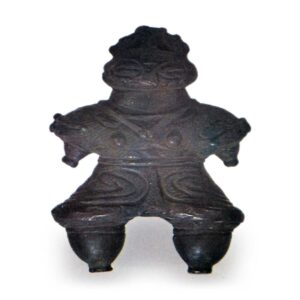

Clay figurines in the shape of a person or animal. In Japan, clay figurines are known as relics of the Jomon period, but in ancient times, human haniwa clay figurines of the Kofun period were also called haniwa-dogu. The majority of clay figurines of the Jomon period were made in the shape of a woman, with some showing breasts, some showing a pregnant woman with an enlarged abdomen, and some showing the pubic region.
The earliest clay figurines in the Kanto region, including the earliest ones dating from the end of the Pioneer Period, are plate-shaped and do not show the face, hands, or feet, and only have protruding breasts. Even in the middle period, many clay figurines were still plate-shaped, with short protruding heads and hands.
However, hollow clay figurines also appeared, as well as those with faces and arms and legs. Some clay figurines of the middle period have three fingers on each hand, a motif that is common to many pottery figurines of the same period, which seem to represent only hands and arms, and is interpreted as a magical expression.
Some large clay figurines of the middle period have realistic feet, and it is interesting to note that some of them have six fingers as a result of the addition of five engraved lines, which indicates the degree of recognition of numbers. In the later period, tubular clay figurines without arms and legs appeared, with a face facing obliquely upward attached to a cylindrical body. Following this, clay figurines with faces and limbs became the norm, and those with triangular necks were called Yamagata-dogu, while those with rounded eyes and mouths were called owl-dogu. Some of them were decorated with earrings, and some of them may have been made with beards or ink brush, which became one of the arguments for the theory that the Japanese Stone Age people were Ainu during the Meiji period. Hollow clay figurines were highly developed in the Kamegaoka culture of the Tohoku region during the Late Stone Age. The eyes of these clay figurines of the first half of the Kamegaoka style are expressed as large lenses. Although the interpretation that these clay figurines represent the snow glasses used by the Arctic peoples is now a thing of the past, the name “shaded-glass clay figurines” is still used today. Clay figurines developed exclusively in eastern Japan, but in the Tohoku region, rock figurines were also made as stone products. In western Japan, clay figurines are found only in the Late Period. Some clay figurines of the Late Period lacked the expression of arms and legs and were shaped like bronze weights. In the Kinki region, some Late Period clay figurines are rough and have a vertical hole. Some people call them “digestive organ clay figurines” because they represent the mouth to the anus. Clay figurines are usually decorated with designs common to pottery of the period. In addition, some clay figurines are decorated with patterns that appear to be clothing. Some of the animal representations from the Paleolithic period on the Old Continent are thought to be representations of internal organs, and this type of representation is also found on the Eurasian, American, and Australian continents, where tattoos are thought to be represented. Some have applied this interpretation to the patterns on clay figurines. Some have also applied this interpretation to clay figurines, which have been interpreted as an expression intended to bring animals back to life, and have been called the X-rays style. The crouching posture is found in many parts of the world, and there are some examples of this style in Late Period clay figurines. Late period clay figurines are rarely excavated in their entirety, even though they originally had faces and limbs.
There are two interpretations of this: one is that the clay figurines were made to pray for the recovery of the body by removing parts of the body when the body was afflicted, and the other is that they were made to be destroyed after performing a certain function. This interpretation is related to the fact that clay figurines have been found in earthenware vessels buried in dwellings, in holes near furnaces, surrounded by pebbles, and in masonry, etc., and it is thought that clay figurines were made to have life and then buried when they lost their life. The fact that some clay figurines show pregnancy makes us think that they are related to the belief in the earth mother goddess, which is widely seen in agricultural cultures throughout the world. This is one of the arguments used by those who claim that agriculture existed during the Jomon period. Clay figurines are found in prehistoric times all over the world, with the oldest dating back to the Paleolithic period in Europe. The earliest clay figures date back to the Paleolithic period in Europe, and statues made of stone, as well as clay, are widely distributed in the Late Paleolithic period in Eurasia. Even in the early Jomon period, there is a flat gravel figure that seems to have been carved with lines to represent hair and breasts (Kamikuroiwa Cave, Ehime Prefecture).
Another interesting example of clay figurines from agricultural culture is one made of clay mixed with wheat grains in Eastern Europe (Bronze Age Tripolier culture). This is interpreted as a wish for a good harvest of wheat. In general, prehistoric stone and clay figurines can be divided into those of food-gatherers and those of food-producers, and Jomon clay figurines are considered to belong to the former group. In the Jomon period, there are also clay figurines representing animals. One example (excavated from Kameoka, Aomori Prefecture) is a clay figurine depicting a realistic representation of a boar. The purpose of these clay figurines is not clear. (Teruya Esaka, “Clay Figure,” Nihon Genbutsu Bijutsu [Japanese Primitive Art], 2)


